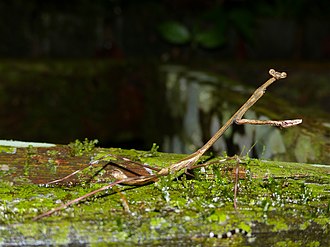Description
Euchomenella Heteroptera (Giraffe Mantis) L3+ - Image is for illustration purposes only!
Housing
- Enclosure: A vertical or tall enclosure is necessary to accommodate the climbing and hanging behaviour essential for molting. For an L3 instar, a container around 20cm tall should suffice. Ensure the enclosure has good ventilation while keeping humidity controlled.
- Substrate: A simple substrate like paper towels can be used for easy cleaning. For a more naturalistic setup, you can use coco coir or peat moss. Remember to change the substrate regularly to maintain cleanliness.
- Humidity: Giraffe Mantises thrive in a humidity range of 60-70%. Achieve this by misting the enclosure with water every day or two, allowing the enclosure to dry out slightly between mistings to prevent mold growth.
- Temperature: Maintain a daytime temperature of 24-30°C (75-86°F), with a slight drop at night. This can often be achieved at room temperature, but you may need a gentle heat source in cooler conditions.
Feeding
- Diet: Feed your Giraffe Mantis appropriately sized live prey, such as fruit flies for smaller instars, moving on to larger prey like houseflies, small crickets, or other small insects as they grow. Feed every 2-3 days, adjusting based on the mantis's appetite and condition.
- Feeding Tips: Make sure the prey items are not too large for the mantis to handle, especially for younger instars. Remove uneaten prey to avoid stress and potential harm to the mantis.
General Care
- Molting: Provide structures such as branches, twigs, or mesh for the mantis to hang from during molting. This species requires vertical space to molt properly, so ensure your enclosure accommodates this need.
- Handling: While the Giraffe Mantis can be handled, it's best to keep handling to a minimum to reduce stress. Always be gentle and cautious when handling, and avoid handling altogether during the molting period.
Social Needs
-Euchomenella heteroptera is a solitary species and should be kept alone to prevent cannibalism, which is common among mantises. They do not require interaction with other mantises for their well-being.
Observation and Adjustment
- Regularly observe your mantis for signs of healthy activity and successful feeding. Adjust the care as needed based on your observations, such as increasing humidity if molting seems difficult or adjusting temperature to encourage more active behaviour.
Order and get 17 reward points
Earn points by signing up for our rewards program

